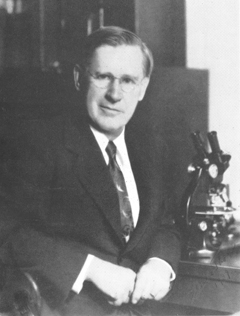Charles Thom
Charles Thom | |
|---|---|
 | |
| Born | November 11, 1872 Minonk, Illinois, U.S. |
| Died | May 24, 1956 (aged 83) Port Jefferson, New York, U.S. |
| Resting place | Storrs, Connecticut |
| Alma mater | University of Missouri |
| Known for |
|
| Scientific career | |
| Fields |
|
| Doctoral advisor | Howard Ayers |
| Author abbrev. (botany) | Thom |
Charles Thom (November 11, 1872 – May 24, 1956) was an American
Early life
Thom was born in
After graduating from high school, Thom attended
Career
In 1902, Thom went to study with

In 1914, Thom became the Chief of the Microbiological Laboratory at the USDA Bureau of Chemistry, where his job was to study problems with the handling and processing of foods, and to enforce the
During his time at the USDA, Thom became a world authority on the genera
In 1929,
"During his active career in the Department of Agriculture [Thom] identified thousands of cultures for other investigators all around the world, taking little cognizance of the credit that he might or might not receive. He was a selfless and devoted scientist and public servant."
Kenneth B. Raper[1]
Thom held his job with the Bureau of Chemistry until 1927, when the position was abolished. He was then appointed Principal Mycologist of the Division of Soil Microbiology for the newly created
Memberships and honors
Thom was the U.S. Delegate to the 1905 International Dairy Congress held in Paris, France. He helped establish a graduate education program at the USDA. In 1907, he became a charter member of the Dairy Association of America, and in 1918, was appointed President of the Bacteriological Association of Washington. He attended the 1935 International Soil Congress in Oxford, England and was Vice President of the 1939 International Microbiological Congress in New York. He was a member of the National Academy of Sciences, a charter member of the Mycological Society of America, and president of the Society of American Bacteriologists in 1940 and the Society of Industrial Microbiology in 1950. Thom was awarded an Honorary Doctor of Science degree by Lake Forest College in 1936. For his work on penicillin, he and his research group received the Lasker Group Award in 1946, and the USDA Distinguished Service Award in 1947. The same year, he received a gold medal from the Spanish National Research Council for his contributions to microbiology and medicine.[1]
Described taxa
- Aspergillus alliaceus Thom & Church 1926
- Aspergillus caespitosus Raper & Thom 1944
- Aspergillus foetidus Thom & Raper 1945
- Aspergillus fonsecaeus Thom & Raper 1965
- Aspergillus granulosus Raper & Thom 1944
- Aspergillus janus Raper & Thom 1944
- Aspergillus niveoglaucus Thom & Raper 1941
- Aspergillus panamensis Raper & Thom 1944
- Aspergillus quadrilineatus Thom & Raper 1939
- Aspergillus ruber Thom & Church 1926
- Aspergillus rugulosus Thom & Raper 1939
- Aspergillus schiemanniae Thom 1916
- Aspergillus sparsus Raper & Thom 1944
- Aspergillus terreus Thom 1918
- Aspergillus variecolor Thom & Raper 1939
- Eupenicillium gladioli L. McCulloch & Thom 1928
- Penicillium atramentosum Thom 1910
- Penicillium avellaneum Thom & Turesson 1915
- Penicillium biformeThom 1910
- Penicillium brasiliense Thom 1930
- Penicillium camemberti Thom 1906
- Penicillium chrysogenum Thom 1910
- Penicillium citrinum Thom 1910
- Penicillium columnare Thom 1930
- Penicillium commune Thom 1910
- Penicillium crustosum Thom 1930
- Penicillium roqueforti Thom 1906
- Penicillium rugulosum Thom 1910
Selected publications
- Thom, Charles (1906) "Fungi in cheese ripening; Camembert and Roquefort" in USDA Bureau of Animal Industry Bulletin 82 pp. 1–39
- Thom, Charles (1910) "Cultural studies of species of Penicillium" in USDA Bureau of Animal Industry Bulletin 118 pp. 1–109
- Thom, Charles; Currie, James N. (1916) "Aspergillus niger group" in Journal of Agricultural Research 7:1 pp. 1–15
- Thom, Charles; Church, Margaret B. (1918). "Aspergillus fumigatus, A. nidulans, A. terreus n. sp. and their allies". American Journal of Botany. 5 (2): 84–104. JSTOR 2435130.
- Thom, Charles; Church, Margaret B. (1921). "Aspergillus flavus, A. oryzae and associated species". American Journal of Botany. 8 (2): 103–126. JSTOR 2435149.
- Thom, Charles; Hunter, Albert Clayton (1924). "Hygienic Fundamentals of Food Handling" 228 pp.
- Thom, Charles; Church, Margaret B. (1926). "The Aspergilli". 272 pp.
- Thom, Charles (1930). "The Penicillia". 644 pp.
- Thom, Charles (1954). "The evolution of species concepts in Aspergillus and Penicillium". Annals of the New York Academy of Sciences. 60 (1): 24–34. S2CID 42412438.
See also
References
- ^ a b c d e f g h i j k Raper KB. (1965). "Charles Thom 1872–1956" (PDF). Biographical Memoirs. 38: 309–44.
- ^ JSTOR 3755740.
- ^ Rogers DP. (1977). A Brief History of Mycology in North America. Cambridge, Massachusetts: Harvard University Printing Office. pp. 30–31.
- ^ PMID 13398356.
- ISBN 0-521-11295-8.
- PMC 2048009.
- ISBN 978-0-85404-634-8.
- ^ "American Chemical Society International Historic Chemical Landmarks. Discovery and Development of Penicillin, 1928–1945". American Chemical Society, Royal Society of Chemistry. 1999. Retrieved 2012-11-07.
- PMID 22679592.
External links
- Charles Thom Papers at the Archives of the New York Botanical Garden including correspondence, manuscripts, research notes, an index card file of mycological literature, photographs, negatives, drawings, and personal papers
- Works by Charles Thom at Project Gutenberg
- Works by or about Charles Thom at Internet Archive
